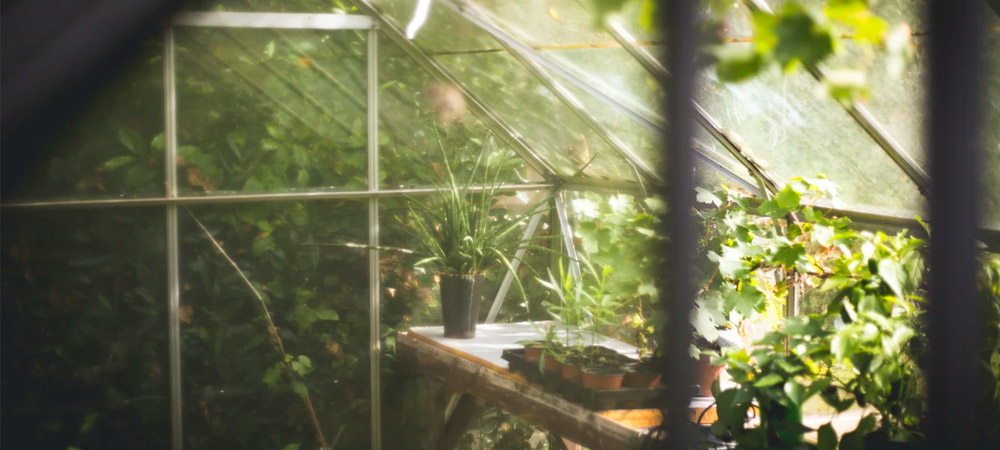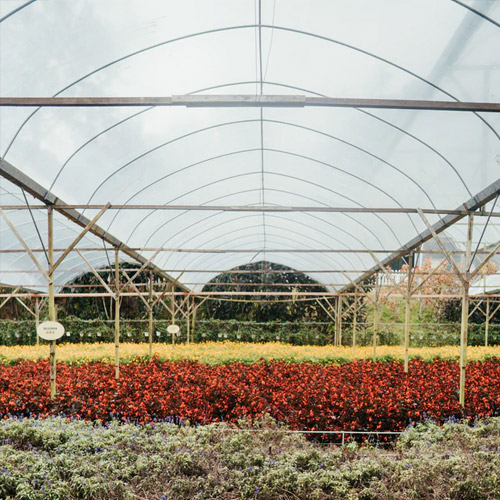Greenhouse - Definition and History

Navigation:
 What is a Greenhouse?
What is a Greenhouse?
A greenhouse is a structure transparent walls and roof, often located outside, and usually used to grow plants in.
Because it is made using transparent materials (such as glass) the plants are exposed to the sunlight but protected from the cold.
The interior of a greenhouse is always much warmer than the external temperature making it an ideal location to grow plants that need warmth. A greenhouse can be any size.
From a small box with a glass lid (known as a cold frame) to commercial greenhouses which are often huge industrial-sized structures. It is sometimes referred to as a glasshouse or a hothouse.
 What is a Commercial Greenhouse?
What is a Commercial Greenhouse?
A commercial greenhouse is a greenhouse used for the mass production of plants or produce (such as vegetables) that will be sold to retailers, who will sell them to the general public.
They are often high tech structures controlled by a computer. Walking into one may feel a bit like walking into a sophisticated science lab.
They often house complex equipment to control heating, cooling, lighting, relative humidity and vapour-pressure deficit.
Gardeners use all of this equipment and various techniques to ensure the optimal production of their plants, vegetables and fruit.
Many commercial glass greenhouses or hothouses are high tech production facilities for vegetables, flowers or fruits.
Types of Greenhouses
By Materials Used
- Aluminium Greenhouses
- Wooden Greenhouses
- Polycarbonate Greenhouses
- Plastic Greenhouses
- Toughened Glass Greenhouses
By Style
By Location
By Width in Feet
- 4ft Greenhouses
- 5ft Greenhouses
- 6ft Greenhouses
- 7ft Greenhouses
- 8ft Greenhouses
- 9ft Greenhouses
- 10ft Greenhouses
By Generic Size
By Brand
By Colour
- Black Frame Greenhouses
- White Frame Greenhouses
- Silver Frame Greenhouses
- Red Frame Greenhouses
- Grey Frame Greenhouses
- Green Frame Greenhouses
- Brown Frame Greenhouses
- Blue Frame Greenhouses
Compare Types of Greenhouses
We have a range of guides to help you choose the best type of greenhouse. Browse them below:
How To Grow in a Greenhouse
We've put together a range of guides on how to grow plants in a greenhouse. Check them out below:
- Chillies
- Tomatoes
- How to Plant Tomatoes in an Unheated Greenhouse
- How to String Tomatoes in a Greenhouse
- Grapes
- Cucumbers
- Peppers
- Lettuce
- Strawberries
- Melons
- Poinsettias
- Garlic
- Orchids
- Lavender
- Kiwi Fruit
- How To Pot and Plant Dahlias
- Greenhouse Gardening for Beginners
- What to Grow in a Greenhouse for Beginners
- What to Grow in a Small Greenhouse
- What to Grow in a Greenhouse in Summer
- What to Grow in a Greenhouse in Winter
- How to Grow Seeds in a Greenhouse
- When To Pinch Out Plants
How to Heat a Greenhouse
We've put together a range of guides on the best ways to heat a greenhouse effectively. Browse them below:
- How to Heat a Greenhouse
- How to Adjust a Greenhouse Auto Vent
- How to Heat a Greenhouse Without Electricity
- How to Heat a Greenhouse in Winter
- Are Paraffin Heaters Safe?
- How to Insulate a Greenhouse
- How to Attach Bubble Wrap to a Greenhouse
- How to Shade a Greenhouse
- Internal vs External Shade for a Greenhouse
History of the Greenhouse
The idea of the greenhouse to grow plants year round has been around longer than you might guess. In Roman times the gardeners used a structure similar to a greenhouse to ensure that the Roman emperor Tiberius could have his cucumber-like vegetable daily. The gardeners would plant the cucumbers in a cart that could be wheeled daily into the sun and stored in a cucumber house to keep them warm at night.
Sanga Yorok, is a Korean cookbook written by Jeon Soon (a royal physician) in the 1450’s and it contains the first description of a greenhouse in it’s chapter on how to grow vegetables in the winter. The book contains detailed instructions on how to build and use a greenhouse to cultivate plants in an artificially heated space. The author explains how using ondol, (a Korean underfloor heating system) and hanji (traditional Korean handmade paper) greenhouses can maintain enough heat, light and protection in the winter months to successfully grow plants. The Annals of the Joseon Dynasty provide further evidence of the early use of greenhouses, stating that structures utilizing ondol were used in 1938 to keep mandarin orange trees growing and healthy throughout the winter.
In the 17th century, historians note the use of greenhouses in the Netherlands and England. There was a significant amount of difficulty with these early greenhouses and providing enough heat to keep plants alive throughout the winter months was not always successful. In 1681, The Chelsea Physic Garden (one of the oldest botanical gardens in the UK) boasted the first stove heated greenhouse in the UK. Currently, the Netherlands produces millions of fruits and vegetables annually and can proudly proclaim to have many of the largest greenhouses in the world.
Greenhouses continued to get bigger and better throughout the seventeenth century in Europe. Take, for example, the Palace of Versailles with it’s expansive greenhouse of more that 150 meters (490ft) in length, 13 meters (43 ft) in width and 14 meters (46 ft) in height!
During the 1800’s, the science of botany became popular when the French botanist Charles Lucien Bonaparte constructed the first practical modern greenhouse in Leiden, Holland, to grow medicinal tropical plants. Greenhouse gardeners eventually spread their knowledge of botany to the universities.
The first greenhouses in France were used primarily to protect the oranges they grew and were called orangeries. When pineapples became more common pineries, or pineapple pits, were also constructed.
In 1840 the Kew Gardens in London, England boasted elaborate and huge greenhouses, beginning the trend of the wealthy upper classes competing to construct the most beautiful and intricate structures to house their plants. A good example of this is Joseph Paxton (first known as the head gardener at Chatsworth, in Derbyshire). Joseph Paxton worked tirelessly with both glass and iron to design The Crystal Palace in London which was built for both horticulture and non-horticulture showcases.
There are several other notable greenhouses built throughout the nineteenth century including the New York Crystal Palace, Munich’s Glaspalast and the Royal Greenhouses of Laeken (1874–1895) for King Leopold II of Belgium.
Samuel Cocking, a British merchant who exported herbs has the honour of having built the first Japanese greenhouse in 1880.
The geodesic dome is an impressive development of greenhouse construction in the 20th century. Remarkable examples are the Eden Project, in Cornwall, The Rodale Institute in Pennsylvania, the Climatron at the Missouri Botanical Garden in St. Louis, Missouri, and Toyota Motor Manufacturing Kentucky.
It was not until the 1960’s, when larger sheets of polyethylene (polythene) film, also known as plastic, became widely available that greenhouses were really able to become accessible to all people. At this time, hoop houses or polytunnels were often constructed by growers at home or could be purchased from several different companies for a relatively inexpensive price. These structures were much cheaper to construct which resulted in a lot more individual people and smaller farms owning their own greenhouses. Greenhouses were no longer only for the wealthy. People could use aluminium extrusions, galvanized steel tubing, or even just lengths of steel or PVC water pipe to build a greenhouse. When polyethylene film durability increased, and more effective UV-inhibitors were developed in the 1970's, the life of a greenhouse was extended from a couple of years to more than four years.
In the 1980’s and 1990’s it became common to see gutter-connected greenhouses and they are now commonly used wherever plants are grown for consumers. A gutter-connected greenhouse is composed of two or more separate structures that are connected together by a common wall or support posts. Usually, this type of greenhouse will have a roof made of polycarbonate materials, or a double layer of polyethylene film with air blown between the layers. This provides increased heat to the plants inside.
Want to know how to choose a greenhouse? Checkout our buyers guide here.
Dismantling a greenhouse? We've got a guide on that too!
Also learn how to clean a greenhouse here.
South West Greenhouses are a UK based greenhouse retailer, with a longstanding history of fantastic reviews, serving customers for many years.
 Author:
Author: